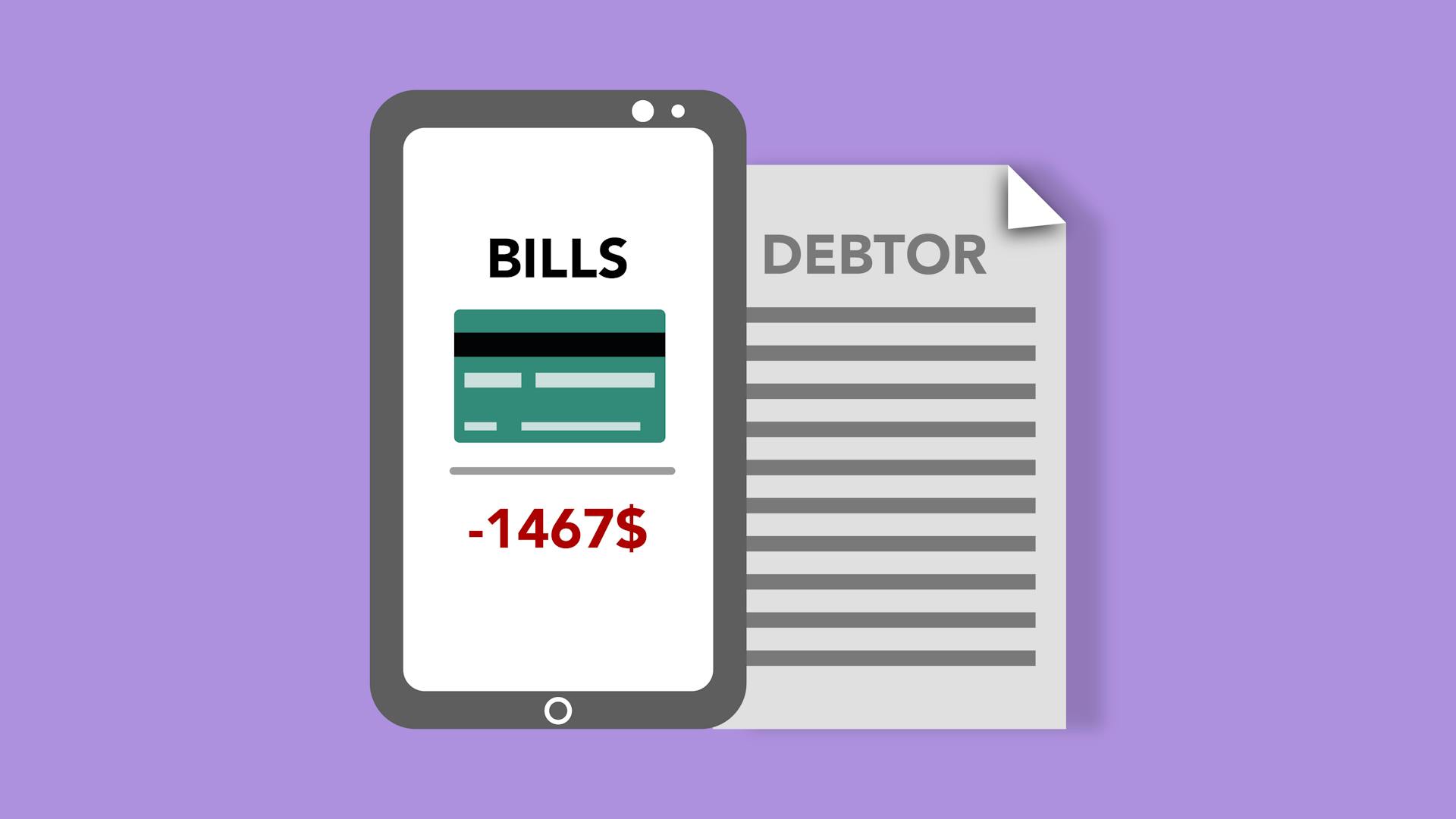
Creating a debt resolution plan requires understanding your financial situation and identifying areas for improvement.
Start by gathering all your debt information, including credit card balances, loan amounts, and interest rates. This will help you see the big picture and prioritize your debts accordingly.
A debt-to-income ratio of 36% or less is generally considered manageable, but if your ratio is higher, you may need to consider debt consolidation or other strategies.
To create a plan that works, set realistic goals and break them down into smaller, achievable steps.
What Is Relief?
Debt relief is a term that can mean many different things, but ultimately, its main goal is to change the terms or amount of your debt so you can get back on your feet faster.
The main goal of debt relief is to get back on your feet faster.
Debt relief can involve negotiating with creditors to settle the debt for less than the full amount owed, wiping the debt out altogether in bankruptcy, or using a debt management plan to get changes in your interest rate or payment schedule.
Suggestion: Secured Loan Advantages
These options can provide a fresh start, but it's essential to understand the process and potential outcomes.
It's possible to settle most debts for less than what is owed, especially those held by debt collection agencies. The goal of debt settlement is to pay less than you owe.
Debt settlement can be a viable option, but it's crucial to work with a reputable company that has a proven track record.
Here are some key statistics about debt settlement:
- Debt settlement provided, on average, $2.64 in consumer savings for every $1 in assessed fees.
- Nearly all offered settlements — more than 98% — resulted in a decrease of the client’s debt greater than the accompanying fees.
- The longer clients participate in a debt settlement program, the more savings they see, on average.
- Three out of four debt settlement clients settle at least one account within the first four to six months after enrollment.
- The average client reduced total debt of approximately $30,000 to $35,000 at the time of settlement, by approximately $9,500 after deducting fees.
Options for Debt Relief
If you're struggling to pay off debt, there are several options to consider. DIY debt relief can be a good starting point, where you handle debt on your own through debt consolidation, appeals to creditors, credit counseling, and stricter budgeting. This approach can help you avoid fees associated with debt-relief programs.
Debt settlement is another option, but it's considered a last resort and may come with risks. You can settle most debts for less than what's owed, especially those held by debt collection agencies. However, it's essential to be aware that debt settlement can stay on your credit report for seven years and may have penalties for missed payments and charged-off debt.
Here are some key points to consider when evaluating debt relief options:
- Debt settlement can result in a decrease of the client's debt greater than the accompanying fees, with an average of $2.64 in consumer savings for every $1 in assessed fees.
- The longer you participate in a debt settlement program, the more savings you see, on average.
- Three out of four debt settlement clients settle at least one account within the first four to six months after enrollment.
- The average client reduces total debt of approximately $30,000 to $35,000 at the time of settlement, by approximately $9,500 after deducting fees.
When to Seek Relief
If you're struggling to pay off debt, it's essential to know when to seek relief. You should consider DIY debt relief, bankruptcy, or debt management when you have no hope of repaying unsecured debt within five years, even with extreme spending cuts.
The total amount of unpaid unsecured debt, excluding student loans, should also be considered. If it equals half or more of your gross income, seeking debt relief may be necessary.
You can pay part of your balance now to avoid interest and penalties, and then explore options like debt settlement or credit counseling.
Debt settlement can be a viable option if you're looking for a fresh start. It can erase debts for less than the total owed, and may be the cheapest option compared to credit counseling or making minimum monthly payments.
For another approach, see: When Should You Open a Credit Card Account

However, it's crucial to note that debt settlement can stay on your credit report for seven years, and you may still face penalties for missed payments and charged-off debt.
Here are some key factors to consider when deciding whether to seek debt relief:
Ultimately, seeking debt relief is a personal decision that depends on your individual circumstances. It's essential to weigh the pros and cons of each option and consider what's best for your financial situation.
Options to Consider
If you're struggling with debt, there are several options to consider.
You can try debt consolidation by moving your debt to a credit card with a 0% introductory APR, allowing you to make faster progress on paying off your balance.
Debt settlement is another option, which involves negotiating with creditors to reduce the amount you owe. According to the Consumer Financial Protection Bureau, debt settlement companies typically ask you to stop making payments and put the money in an escrow account.
However, debt settlement can be a risky option, and it's not always the cheapest solution. In fact, a study found that debt settlement provided, on average, only $2.64 in consumer savings for every $1 in assessed fees.
If you're considering debt settlement, it's essential to research and choose a reputable company that is associated with the American Fair Credit Council (AFCC) and its strict code of conduct.
Here are some key statistics to consider:
- Debt settlement provided, on average, $2.64 in consumer savings for every $1 in assessed fees.
- Nearly all offered settlements — more than 98% — resulted in a decrease of the client’s debt greater than the accompanying fees.
- The longer clients participate in a debt settlement program, the more savings they see, on average.
- Three out of four debt settlement clients settle at least one account within the first four to six months after enrollment.
- The average client reduced total debt of approximately $30,000 to $35,000 at the time of settlement, by approximately $9,500 after deducting fees.
Ultimately, the best option for you will depend on your individual circumstances and financial goals. It's essential to carefully weigh the pros and cons of each option and consider seeking advice from a financial advisor if needed.
Types of Eligible
Credit cards and medical bills are ideal for debt settlement, as they can be settled for a lump sum payment. This is especially true for consumers facing seriously delinquent credit card debt, 90 days past due.
Typically, federal student loan balances are highly resistant to debt settlement schemes. However, private student loans, usually issued by banks, are a better target for debt settlement.

The New York Federal Reserve reports that credit card delinquencies are at their lowest in 18 years, at 4.1% of accounts delinquent at the end of 2021.
To understand the debt settlement process for federal student loans, here are the three conditions under which a collection agency can accept a lump-sum payment:
- You pay the balance of the loan and interest, but not the collection agency charge.
- You pay the principal plus half the unpaid interest.
- You pay 90% of the remaining principal and interest.
Bankruptcy Options
If you're struggling with debt, bankruptcy might be an option worth considering. You can talk with a bankruptcy attorney for a free initial consultation to determine if it's the right choice for you.
There are two main types of bankruptcy: Chapter 7 and Chapter 13. Chapter 7 liquidation can erase most credit card debt, unsecured personal loans, and medical debt, but it will hurt your credit scores and stay on your credit report for up to 10 years.
Chapter 7 bankruptcy won't erase child support obligations, and it will make a co-signer solely responsible for the debt. If you have used a co-signer, be aware of this consequence.
Broaden your view: Credit Cards with Cosigners

Chapter 7 bankruptcy can be done in three or four months if you qualify, but you may not be able to keep certain property, such as vehicles or part of the equity in your home, depending on your state's rules.
Chapter 13 bankruptcy is a three- or five-year court-approved repayment plan based on your income and debts. If you stick with the plan, the remaining unsecured debt is discharged, and you get to keep your property.
Chapter 13 bankruptcy stays on your credit report for seven years from the filing date, which is shorter than the 10-year period for Chapter 7.
Bankruptcy provides legal protection from creditors and offers a fresh start by discharging or restructuring your debts. However, it can have long-lasting consequences for your credit scores and financial standing.
Intriguing read: Can You Max Out Credit Cards before Filing Chapter 7
Risks and Consequences
Debt settlement can be a complex and potentially risky process. You could end up with debts that are even bigger than when you started, due to late fees, interest, and other charges.

Mounting interest and late fees can cause your balance to balloon, often to alarming totals. This can happen even when you're working with a debt settlement company.
Not paying your bills can result in collections calls, penalty fees, and potentially, legal action against you. Lawsuits can lead to wage garnishments and property liens.
The debt settlement business is riddled with bad actors, and reputable organizations like the CFPB, National Consumer Law Center, and Federal Trade Commission caution consumers about it in the strongest possible terms.
The process of funding an escrow account large enough to enable the debt settlement company to make an attention-getting offer to your creditors typically takes 36-48 months. This can be a long and frustrating process.
Here are some potential consequences of debt settlement:
- Negative credit score impact: Debt settlement can negatively impact your credit score, as settled accounts may be reported as “settled” or “charged-off”. A debt settlement may remain on your credit report for up to seven years.
- Tax implications: The IRS counts the forgiven portion of your debt as taxable income, which may result in additional tax liabilities.
- Fees and costs: Debt settlement companies may charge fees for their services, which can add to your overall debt burden.
- Damage to credit report: Your credit report and credit score will be stained for seven years, showing the account as “settled”, or not paid in full.
- Loss of credit score points: The pummeling to your credit score will range between 100-125 points.
- Difficulty getting credit: The “settled” designation will be a black mark when you seek a loan or a line of credit; lenders factor it into the decision of whether to take a chance on lending you money again.
Settling Debt
Settling debt can be a viable option for those overwhelmed by debt, but it's essential to understand the process and its implications. You can hire a debt settlement company or try to negotiate yourself, with the latter option being a cost-effective choice but requiring careful approach and preparation.

Debt settlement companies can provide a forcefield against intimidation tactics, enabling them to negotiate a settlement that results in real savings and an opportunity to start fresh. On average, debt settlement provided $2.64 in consumer savings for every $1 in assessed fees.
Negotiating with creditors directly can be a daunting task, but it's possible to achieve savings by paying what you can now to help avoid interest and penalties. Nearly all offered settlements – more than 98% – resulted in a decrease of the client’s debt greater than the accompanying fees.
To increase your chances of success, consider seeking guidance from reputable financial resources or consumer advocacy organizations. The longer clients participate in a debt settlement program, the more savings they see, on average.
Here are some key statistics to keep in mind:
Choosing a Debt Settlement Company
Choosing a debt settlement company is a crucial decision that can significantly impact your financial future. Research your options to identify reputable debt settlement companies with a track record of success and positive client reviews.

Start by checking online reviews, consumer advocacy websites, and other relevant resources to gather insights into the company's reputation and credibility. Choose a debt settlement company that provides clear and transparent information about its fees, services, and the debt relief process. Debt settlement outcomes can vary depending on individual circumstances and creditor cooperation.
Avoid companies that make promises or guarantee specific results. Look for companies that are accredited by a reputable industry watchdog, such as the American Fair Credit Council (AFCC). Some key features of a reputable debt settlement company include:
- The funds in the escrow account are yours, and you are entitled to the interest earned.
- You can withdraw from your balance at any time without penalty (however, this will hinder your progress).
- The account administrator is not part of the debt settlement company.
Remember, a good debt settlement company will disclose all program fees and costs before you sign up, have easy-to-understand written policies, and provide a good-faith estimate of how many months/years it will wait before making an offer to each creditor.
For your interest: Will Debt Collectors Sue You in Sc
Choosing a Company
A good debt settlement company will be transparent about its fees and have a demonstrated history of superb customer service. This is crucial, as you'll want to know exactly how much you'll be paying and what you can expect from the company.
You might like: Consumer Finance Company Loan
The best debt settlement agencies are accredited by a reputable industry watchdog, such as the American Fair Credit Council (AFCC). This means they've met certain standards and are committed to fair and transparent practices.
To ensure you're working with a reputable company, look for the following features: clear and easy-to-understand written policies, a good-faith estimate of how many months or years it will take to make offers to each creditor, and an estimate of intended results without guaranteeing a specific settlement amount.
Here are some key features to consider when choosing a debt settlement company:
- The company discloses all program fees and costs before you sign up.
- The company has easy-to-understand written policies about its debt resolution program.
- The company provides a good-faith estimate of how many months/years it will wait before making an offer to each creditor.
- The company estimates its intended results, but never guarantees a specific settlement amount.
- The company tells you how much money you must save up before it will begin making offers to your creditors.
- The company sends all resolution offers to you for your approval.
Remember, a debt settlement company cannot guarantee an agreement with your creditors, so be wary of companies that make promises or guarantee specific results.
Check this out: Section 184 Indian Housing Loan Guarantee Program
Signing a Credit Card Agreement
Signing a credit card agreement is a crucial step in the debt settlement process. Get all arrangements in writing for your records, including the agreement itself.
Your credit card company should sign the agreement, and you should too. This ensures that both parties are on the same page.
The account administrator will be responsible for transferring funds from your account to pay your creditor once the agreement is signed.
A fresh viewpoint: Debt Resolution Agreement
Preparing for Debt Settlement

You can start saving money by making monthly deposits into an escrow account in preparation for debt negotiations. This process can take from several months to a few years, depending on your budget and anticipated amount to be resolved.
A debt settlement company will tell you the total amount you need to save in advance, which is typically stored in a dedicated bank account insured by the Federal Deposit Insurance Corporation (FDIC). This account will be overseen by a trustee or account administrator.
The average client reduces total debt of approximately $30,000 to $35,000 at the time of settlement, by approximately $9,500 after deducting fees. This is a significant savings, especially considering that debt settlement companies have a track record of providing consumer savings for every dollar in assessed fees.
You can expect to pay fees, but nearly all offered settlements result in a decrease of the client's debt greater than the accompanying fees. In fact, debt settlement provided, on average, $2.64 in consumer savings for every $1 in assessed fees.
Three out of four debt settlement clients settle at least one account within the first four to six months after enrollment. This is a promising statistic, especially for those who are committed and disciplined in their approach.
Expand your knowledge: Average Saving Account Balance
Tax and Credit Implications

Debt settlement can have significant tax implications, so it's essential to consult with a tax professional to understand the consequences.
The IRS may consider forgiven debt as regular income, which can affect your taxes. Creditors may report the unpaid portion of your original balance to the IRS, triggering this tax obligation.
This tax consequence can be a surprise for many people, but it's crucial to plan for it when considering a debt resolution plan.
Additional reading: How to Check If You Owe Money to Irs
Tax Obligations
Tax Obligations can have a significant impact on your financial situation.
Creditors may report the unpaid portion of your original balance to the Internal Revenue Service.
The IRS will regard your forgiven debt as regular income. This can affect your taxes, potentially increasing your tax liability.
Speak with a tax professional to understand the tax consequences of debt settlement. They can help you navigate the complex rules surrounding forgiven debt.
Your Credit
Your credit scores can plummet if you're struggling with debt, but getting out of debt is your top priority.
If you're considering debt settlement, know that your credit scores may already be damaged. If your credit scores are still decent, you might want to explore other options.
A settlement can stay on your credit report for about seven years and may harm your credit score. You can try asking your credit card company to report the settlement as "paid in full" instead.
Once your debts are settled and you're managing your finances well, your credit scores will start to recover.
Alternatives
You don't have to use a debt settlement company to get debt relief. It's possible to get debt relief without one.
Negotiating directly with creditors is an alternative to debt settlement. You can try to work out a payment plan with them.
Debt management plans can also provide a way out of debt. These plans typically involve making one monthly payment to a credit counselor, who then distributes it among your creditors.
Credit counseling agencies can help you create a debt management plan. They can negotiate with your creditors on your behalf.
Consolidating debt into a single loan with a lower interest rate can be a debt relief option. This can simplify your payments and save you money on interest.
Create a Plan
Creating a debt resolution plan requires a clear understanding of your financial situation and a solid strategy to tackle your debts. You can start by identifying your debts, including credit cards, loans, and other unsecured debts.
To create a plan, you'll want to consider two popular debt repayment methods: the avalanche debt payoff method and the snowball debt payoff method. Both methods have their benefits and drawbacks, so it's essential to choose the one that works best for you.
The avalanche method involves paying off the debt with the highest interest rate first, while the snowball method focuses on paying off the smallest debt balance first. A major benefit of the avalanche method is that you'll save money on interest, but it can take longer to pay off the first debt.
To start, make the minimum payments on all your debts, and then apply as much money as possible to the debt with the highest interest rate or the smallest balance. This will help you stay organized and motivated.
Here's an interesting read: What Is an Advantage to Using the Debt Snowball Method
It's also essential to prioritize your debts and create a plan to pay them off over time. Rearranging your debts in order of priority can help you stay on track and make greater headway in paying off your debts.
Here are some key steps to consider when creating a debt resolution plan:
- Identify your debts and their interest rates
- Choose a debt repayment method (avalanche or snowball)
- Make the minimum payments on all debts
- Apply as much money as possible to the debt with the highest interest rate or smallest balance
- Prioritize your debts and create a plan to pay them off over time
Managing Debt Payments
A debt management plan allows you to pay your unsecured debts in full, often at a reduced interest rate or with fees waived.
You'll need to make a single payment each month to a credit counseling agency, which will distribute it among your creditors.
Missing payments can knock you out of the plan, so it's essential to pick an agency accredited by the National Foundation for Credit Counseling or the Financial Counseling Association of America.
Pay what you can now to help avoid interest and penalties, then choose an option to pay off your balance over time.
For more insights, see: Counseling Debt Consolidation
Apply for a payment plan, also called an installment or online payment agreement, to pay off your balance over time, but fees may apply.
Besides making more than the minimum payment each month, aim to make an extra payment each month to pay off your debt faster.
If you're having problems paying on time, contact your lenders to see if you can move the payment due dates.
Closing a credit card account can negatively impact your credit, but you can freeze your credit card account to momentarily hit the "pause" button on your card.
Lowering living expenses means more money can go toward your debt, so see where you can cut back on your expenses.
Get creative and track your progress by way of a debt thermometer, or create a grid of squares, with each square representing $100.
Negotiate with the collection agencies directly to create an agreement on a payment plan, and be prepared to make an offer.
Worth a look: Pag-ibig Salary Loan Online Apply
Emotional and Motivational Aspects
Having debt can be an emotional rollercoaster, with feelings of grief, denial, shame, fear, stress, anxiety, and anger swirling around. It's normal to feel like debt is eclipsing joy and happiness in your life.
Understand that you're not alone in this struggle. Many people carry debt, and it's a process that requires acceptance and management of your emotions.
Paying off debt can be a long and arduous journey, but channeling your emotions into motivation can be a powerful tool. For example, Melanie Lockert, who paid off $81,000 in student loans, used her anger as a motivator, paying off her debt instead of letting the feeling fester.
Stay Motivated
Staying motivated is key to successfully paying off debt. It's a long and arduous journey, but with the right mindset, you can stay on top of your plan.
Anger can be a powerful motivator when it comes to debt payoff. For Melanie Lockert, who paid off $81,000 in student loans, she sublimated anger into a motivational tool. She channeled it into paying off her debt.
To stay motivated, it's essential to celebrate minor victories along the way. Treat yourself to something simple each time you've passed a checkpoint. This will help you stay positive and encouraged to continue.
Here are some ways to stay motivated:
Remember, paying off debt is a process, and it's normal to feel a range of emotions along the way. By understanding that it's a process, and accepting the emotions that come with debt, you'll be able to manage your payments, but your emotional and mental well-being as well.
Communication and Support
Effective communication is essential for a smooth experience during debt settlement. This means choosing a company that offers personalized guidance and regular updates on the progress of your settlements.
A company that provides regular updates can help alleviate stress and anxiety that often comes with debt settlement. This is especially important when you're dealing with a complex financial situation.
Personalized guidance can also help address concerns and questions you may have throughout the process. A good company should have a clear communication channel in place to ensure you're informed and supported every step of the way.
Regular updates can also help you stay motivated and engaged in the debt settlement process. By knowing what's happening with your settlements, you can feel more in control and confident about your financial future.
Additional reading: Credit Cards Debt Help
Frequently Asked Questions
What is the debt resolution program?
Debt resolution is a personalized approach to reducing debt by negotiating with creditors to lower the amount owed or create more manageable repayment terms. It's a tailored solution to help you take control of your finances and achieve debt relief.
Sources
Featured Images: pexels.com

